钳蝎Buthus martensi
又称“东亚钳蝎”。无脊椎动物,蛛形纲,钳蝎科。体长,前端为短的头胸部,口外有螯肢1对和脚须1对,端节均呈钳状。背面体表覆盖一块完整背甲。腹部可分前腹和后腹,后腹末端具有1个尾刺,内具毒腺1对,能向背前方弯曲。体色常因栖息地而异。栖于阴湿地带。昼伏于碎 、树皮等缝隙下面或土穴中,偶藏于室内,夜出觅食,肉食性,主食昆虫、蜘蛛和多足纲动物。卵胎生。成蝎寿命5~8年,繁殖力强,新产幼蝎常负于母蝎背面。耐饥,不耐干。蝎毒具有类似眼镜蛇毒素的作用,毒性较大。由于毒量少,成年人被蜇后,及时处理,后果不大严重。儿童被蜇后,除局部肿痛外,严重可引起全身性神经中毒,出现昏睡、流涎、舌滞、眼斜,可导致心力衰竭而死亡。被蜇后应及时治疗。干燥虫体可入药,称为“全蝎”。主治惊风抽搐、风湿痛等症。现已进行人工饲养。
、树皮等缝隙下面或土穴中,偶藏于室内,夜出觅食,肉食性,主食昆虫、蜘蛛和多足纲动物。卵胎生。成蝎寿命5~8年,繁殖力强,新产幼蝎常负于母蝎背面。耐饥,不耐干。蝎毒具有类似眼镜蛇毒素的作用,毒性较大。由于毒量少,成年人被蜇后,及时处理,后果不大严重。儿童被蜇后,除局部肿痛外,严重可引起全身性神经中毒,出现昏睡、流涎、舌滞、眼斜,可导致心力衰竭而死亡。被蜇后应及时治疗。干燥虫体可入药,称为“全蝎”。主治惊风抽搐、风湿痛等症。现已进行人工饲养。

钳蝎
钳蝎scorpion
Buthus martensi Karsch,又称蝎。蛛形纲,钳蝎科。体长形,头胸部有背甲。腹部分前腹和后腹两部。前腹部宽,7节;后腹部狭长,5节,能向前弯曲。最后有一尾刺,内具毒腺,在尾刺尖端开孔。有中眼一对,单眼三对。头胸部有附肢6对,第一、二对附肢为螯肢和脚须,两者均呈螯状,其余4对为步足,卵胎生。喜栖于干燥地区。昼伏夜出。肉食性,捕食昆虫、蜘蛛和蜈蚣等动物。能耐饥、耐渴,可长期不需要水,种间有互残习性。全蝎可入药,有镇痉、止痛、熄风等功能。在中国已人工饲养。

钳蝎
- hookworm
- Hooper,William
- hoopoe
- Hoover Dam
- Hoover lnstitution on War,Revolution,and Peace
- Hoover,Herbert Clark
- Hoover,John Edgar
- hop
- Hopewell Culture
- Hope,Anthony
- Hope,Bob
- hop-hornbeam
- Hopi
- Hopkinson,Francis
- Hopkinson,John
- Hopkins,Gerard Manley
- Hopkins,Harry Lloyd
- Hopkins,Sir Frederick Gowland
- Hopkins,Stephen
- Hoppner,John
- Horace
- Horae
- Horatii and Curiiatii
- Horatius Cocles
- Hore-Belisha,Isaac Leslie,1st Baron